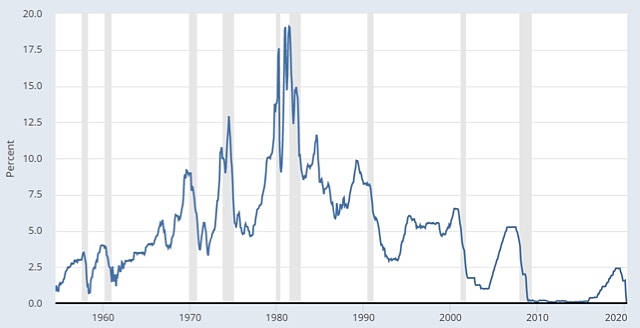Federal Reserve signals years of zero percent interest rates; leading economist predicts US dollar crash

US Federal Reserve chairman Jerome Powell said the COVID-19 induced recession is the “biggest economic shock” in the US and the world in living memory.
“We’re not thinking about raising rates. We’re not even thinking about thinking about raising rates” — US Federal Reserve chairman Jerome Powell said overnight.
The Federal Reserve thus flashed a signal to the markets that it expects the economic recovery from the pandemic-induced recession to be slow, with interest rates to remain near to zero for years to come.
The statement heralded the Federal Reserve’s decision to leave interest rates unchanged between 0% to 0.25%.

Historical interest rates in the US, with shaded areas highlighting a recession.
Mr Powell told reporters that US unemployment is forecast at 9.3% by the end of 2020 after possibly “hitting bottom” with the jobless rate rising to 14.5% in April.
“This is the biggest economic shock, in the US and the world, really, in living memory,” Mr Powell said.
“We went from the lowest level of unemployment in 50 years to the highest level in close to 90 years — and we did it in two months.”
Mr Powell added that millions of people will not get their old jobs back and will not be able to find new ones “for some time”.
Bleak outlook
The Federal Reserve’s bleak news follows just days after the World Bank said it believed the COVID-19 crisis would cause the fourth biggest economic shock to the world’s economy in 150 years and be twice as damaging as the 2008-09 Global Financial Crisis.
Mr Powell signalled that US GDP would decline by 6.5% this year, close to the World Bank’s estimate of 6.1%.
Various news reports claim that the majority of Washington policymakers say that even by 2022 interest rates will still be at the present level.
In this environment, the Federal Reserve will continue to buy Treasuries as well as mortgage-backed securities at the current pace — and since mid-March, has spent US$2 trillion (A$2.9 trillion) buying all that paper.
In fact, just this week the country’s de facto central bank will outlay an expected US$20 billion in soaking up more Treasury bills and US$22.5 billion on mortgage bonds as it tries to stimulate some growth.
There are now voices in Washington calling for negative interest rates on the basis that companies will borrow more money as rates go lower and lift their activities as a result.
Stephen Roach calls US dollar collapse
Meanwhile, economist Stephen Roach has called time on the US dollar.
Mr Roach, a former chairman of Morgan Stanley who now lectures at the Yale School of Management, says that US living standards will be squeezed as never before.
“At the same time the world is having serious doubts about the once widely accepted presumption of American exceptionalism,” he was reported as saying this week.
The problem for the US dollar is a lack of domestic savings and that the US has been relying on surplus savings from abroad, which has come largely from China.
But the US government is pushing economic decoupling from China — and its savings.
“Who will fund the saving deficit of a nation that has lost its exorbitant privilege?”
Mr Roach added “the coming collapse in savings” will put the US dollar under extreme pressure.
This will be followed by a collapse in the dollar, causing a wide sharpening of America’s trade deficit.
“Like COVID-19 and racial turmoil, the fall of the almighty dollar will cast global economic leadership of a savings-short US economy in a very harsh light,” Mr Roach noted.
